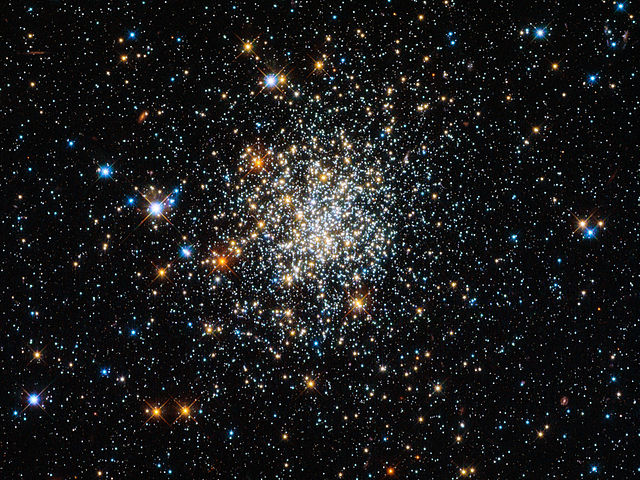
File:Appearances can be deceptive.jpg

| |
This is a file from the Wikimedia Commons. Information from its description page there is shown below.
Commons is a freely licensed media file repository. You can help. |
Summary
| Description |
English: Globular clusters are roughly spherical collections of extremely old stars, and around 150 of them are scattered around our galaxy. Hubble is one of the best telescopes for studying these, as its extremely high resolution lets astronomers see individual stars, even in the crowded core. The clusters all look very similar, and in Hubble’s images it can be quite hard to tell them apart – and they all look much like NGC 411, pictured here.
And yet appearances can be deceptive: NGC 411 is in fact not a globular cluster, and its stars are not old. It isn’t even in the Milky Way. NGC 411 is classified as an open cluster. Less tightly bound than a globular cluster, the stars in open clusters tend to drift apart over time as they age, whereas globulars have survived for well over 10 billion years of galactic history. NGC 411 is a relative youngster — not much more than a tenth of this age. Far from being a relic of the early years of the Universe, the stars in NGC 411 are in fact a fraction of the age of the Sun. The stars in NGC 411 are all roughly the same age, having formed in one go from one cloud of gas. But they are not all the same size. Hubble’s image shows a wide range of colours and brightnesses in the cluster’s stars. These tell astronomers many facts about the stars, including their mass, temperature and evolutionary phase. Blue stars, for instance, have higher surface temperatures than red ones. The image is a composite produced from ultraviolet, visible and infrared observations made by Hubble’s Wide Field Camera 3. This filter set lets the telescope “see” colours slightly further beyond red and the violet ends of the spectrum. |
| Date | 21 January 2013, 10:00:00 |
| Source | http://www.spacetelescope.org/images/potw1303a/ |
| Author | ESA/Hubble & NASA |
Licensing
| Public domainPublic domainfalsefalse |
 |
This file is in the public domain because it was created by NASA and ESA. NASA Hubble material (and ESA Hubble material prior to 2009) is copyright-free and may be freely used as in the public domain without fee, on the condition that only NASA, STScI, and/or ESA is credited as the source of the material. This license does not apply if ESA material created after 2008 or source material from other organizations is in use. The material was created for NASA by Space Telescope Science Institute under Contract NAS5-26555, or for ESA by the Hubble European Space Agency Information Centre. Copyright statement at hubblesite.org or 2008 copyright statement at spacetelescope.org. For material created by the European Space Agency on the spacetelescope.org site since 2009, use the {{ ESA-Hubble}} tag. |
|
File usage
Metadata
| Image title |
|
|---|---|
| Date and time of data generation | 10:00, 21 January 2013 |
| Copyright status | Public domain |
| Online copyright statement | |
| Source | ESA/Hubble |
| Credit/Provider | ESA/Hubble & NASA |
| Usage terms |
|
| Short title |
|
| Keywords | NGC 411 |
| Contact information |
http://www.spacetelescope.org/ Karl-Schwarzschild-Strasse 2 Garching bei München, , D-85748 Germany |
A background to Schools Wikipedia
SOS Childrens Villages has brought Wikipedia to the classroom. SOS Children's Villages is there for the children in our care until they are ready for independence. There are many ways to help with SOS Children's Villages.
